Duranta Erecta Profile: Plant Info, Care & Propagation Guide
Written by Iris
Dec 06 2021
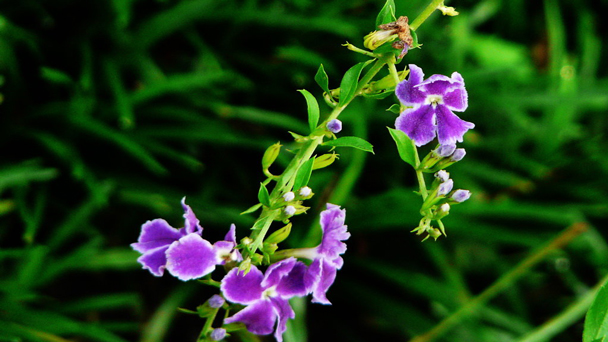
Duranta erecta is a tropical plant and is an important addition to the garden all year round. Duranta erecta has lovely purple flowers from spring to autumn. However, this was not the end of the Duranta erecta showy period. In the fall, they produce bright yellow berries that add color to any garden or flowers.
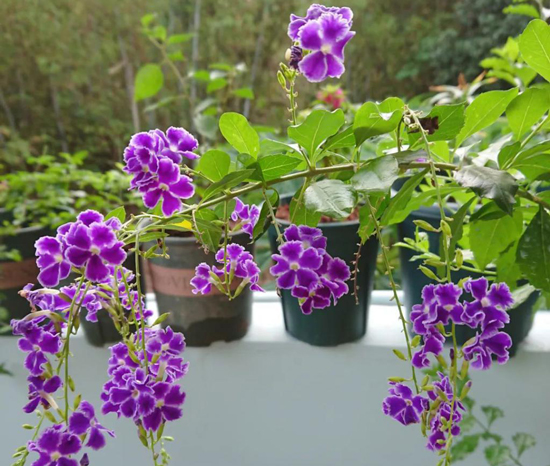
Duranta Erecta Purple Flowers
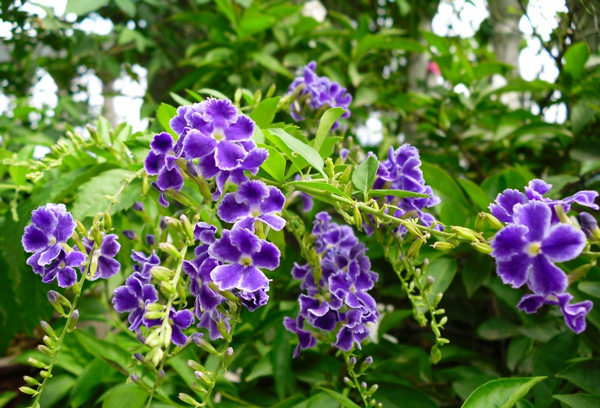
Spread them over a sterile potting mix, pressing slightly into the soil and water moderately.
Ideally, the seeds should be placed at 70° degrees Fahrenheit (21° C) in constantly moist soil.
In the right conditions, germination will take place within 30 to 60 days.
Take the following steps to successfully propagate your plant:
After you have a hardwood cutting, trim it at a point where a leaf bud would grow.
Leave at least two buds above the one at the bottom, and cut the top of the cutting.
Strip off the leaf buds at the bottom, and take off the bark about two inches on top of this.
Dip this end of the cutting into a rooting hormone and then place it into damp soilless mix.
Cover the pot with plastic, making sure that the plastic does not touch the cutting itself but still covers the whole thing.
Place this in indirect sunlight so it stays warm.
Keep checking the pot for root development. You can remove the plastic and start treating it like an adult once the roots have developed.
Find more details on how to grow and care for Duranta Erecta.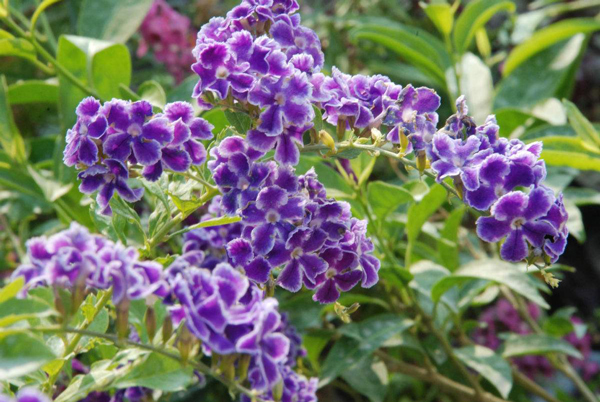
It is traditionally grown in living fences in the northwestern Himalayas, where it helps to exclude livestock and other animals; mark out land boundaries; whilst also providing a range of medicinal and other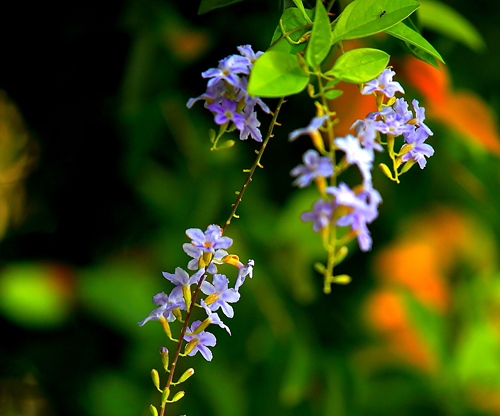
'Alba': This plant forms clusters of white flowers.
'Golden Edge': This variety sports bright gold and green foliage.
'Sapphire Showers': This variety features vivid violet blooms with white edges.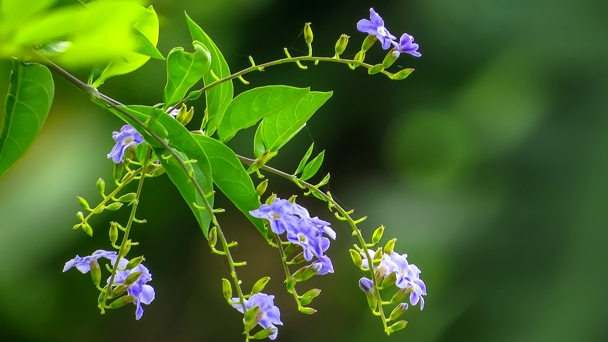
Duranta Erecta PictureDuranta Erecta InfoDuranta Erecta Distribution AreaHow to Grow and Care for Duranta erectaHow to Grow Duranta erectaHow to Care for Duranta erectaUses of Duranta erectaVarieties of Duranta erectaDuranta erecta Common Pests/DiseasesDuranta erecta Companion Plants
Duranta Erecta Picture

Duranta Erecta Purple Flowers
Duranta Erecta Info
| Botanical Name | Duranta Erecta |
| Common Name | Duranta, sky flower, golden dewdrop, pigeon berry |
| Plant Type | Tropical shrub |
| Mature Size | 18 feet |
| Sun Exposure | Full sun |
| Soil Type | Rich loam; tolerates rocky soil |
| Soil pH | Acidic to slightly alkaline (5.6 to 7.5) |
| Bloom Time | Spring through frost |
Duranta Erecta Distribution Area
Duranta Erecta is native to Mexico, the Caribbean, Central America and much of South America. It is also native to the states of Arizona, California, Florida, Louisiana and Texas in the USA. However, other records report that it is introduced in Florida and Texas. This species is widely cultivated across the world and, as a result, has become naturalized in parts of Asia, Africa, the Indian Ocean islands of Mayotte and Reunion and much of Oceania. It is reported to be invasive in China, Taiwan, Hawaii (USA), Fiji, French Polynesia, Tonga and Australia.
How to Grow and Care for Duranta erecta
How to Grow Duranta erecta
- Propagate duranta erecta with Seeds
Spread them over a sterile potting mix, pressing slightly into the soil and water moderately.
Ideally, the seeds should be placed at 70° degrees Fahrenheit (21° C) in constantly moist soil.
In the right conditions, germination will take place within 30 to 60 days.
- Propagate Duranta erecta with Hardwood Cuttings
Take the following steps to successfully propagate your plant:
After you have a hardwood cutting, trim it at a point where a leaf bud would grow.
Leave at least two buds above the one at the bottom, and cut the top of the cutting.
Strip off the leaf buds at the bottom, and take off the bark about two inches on top of this.
Dip this end of the cutting into a rooting hormone and then place it into damp soilless mix.
Cover the pot with plastic, making sure that the plastic does not touch the cutting itself but still covers the whole thing.
Place this in indirect sunlight so it stays warm.
Keep checking the pot for root development. You can remove the plastic and start treating it like an adult once the roots have developed.

How to Care for Duranta erecta
- Light Care
- Soil Care
- Water Care
- Fertilizer Care
- Pruning Care
Find more details on how to grow and care for Duranta Erecta.

Uses of Duranta erecta
- Medicinal Uses
- Agroforestry Uses
It is traditionally grown in living fences in the northwestern Himalayas, where it helps to exclude livestock and other animals; mark out land boundaries; whilst also providing a range of medicinal and other
- Other Uses

Varieties of Duranta erecta
There are several varieties of duranta that feature different color combinations. They include:'Alba': This plant forms clusters of white flowers.
'Golden Edge': This variety sports bright gold and green foliage.
'Sapphire Showers': This variety features vivid violet blooms with white edges.
Duranta erecta Common Pests/Diseases
Outdoor golden dewdrop plants generally remain pest and disease-free. However, when grown indoors, they may be affected by whiteflies. The leaves and unripened berries of the Duranta plant are known to be highly toxic to children and pets; they are fatal. However, the berries become edible once they get ripe. Songbirds (oscines) are known to consume unripe fruits without experiencing any negative effects. The colorful flowers and berries are highly attractive to butterflies and hummingbirds. Birds also play a key role in seed dispersal and are the major reason why sky flower plants become a fast-growing weed in many areas.
Duranta erecta Companion Plants
- Impatiens
- Sweet Potato Vine
- Tweedia
Latest Updated
- Benefits of Bugleweed - 7 Science-backed Health Benefits
- Bugleweed Dangers & Side Effects - Is It Poisonous?
- How to Plant Evergreen Trees - What You Should Know
- When to Plant Evergreens - Grow Guide for Evergreen Trees
- 12 Wonderful Evergreen Shrubs for Your Garden
- 12 Popular Evergreen Plants with Pictures for Beginners
- When And How To Prune A Lilac Bush Like a Pro
- How to Grow & Care for Lilac Vine (Hardenbergia Violacea)
- Japanese Lilac Tree (Syringa Reticulata) Care & Propagation Guide
- Shumard Oak Pros and Cons - What to Know
Popular Articles
- Winter maintenance of Antirrhinum Majus
- How to Grow Terminalia Mantaly Tree
- How to Grow and Care for Crossostephium Chinense
- How to grow Antirrhinum Majus in spring
- Peristeria Elata (Dove Orchid) Profile: Info & Care Guide
- Underwatered Snake Plant (Sansevieria Trifasciata) - Signs And How To Fix
- How to Care for Brazilian Jasmine Plant (Mandevilla Sanderi)
- How to Grow & Care for Graptopetalum Purple Delight in Summer
- Rosa Chinensis (China Rose): Plant Growing & Care Tips
- How to Care for Baby Sun Rose (Aptenia Cordifolia)